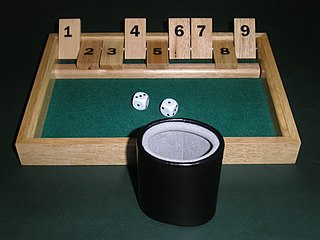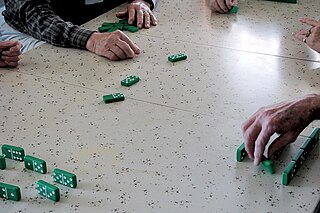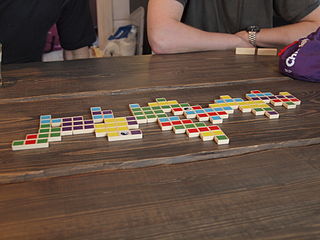
Sternhalma, commonly known as Chinese checkers or Chinese chequers, is a strategy board game of German origin that can be played by two, three, four, or six people, playing individually or with partners. The game is a modern and simplified variation of the game Halma. "Complexity: requires no counting or spelling; even young children can play."

Dominoes is a family of tile-based games played with gaming pieces. Each domino is a rectangular tile, usually with a line dividing its face into two square ends. Each end is marked with a number of spots or is blank. The backs of the tiles in a set are indistinguishable, either blank or having some common design. The gaming pieces make up a domino set, sometimes called a deck or pack. The traditional European domino set consists of 28 tiles, also known as pieces, bones, rocks, stones, men, cards or just dominoes, featuring all combinations of spot counts between zero and six. A domino set is a generic gaming device, similar to playing cards or dice, in that a variety of games can be played with a set. Another form of entertainment using domino pieces is the practice of domino toppling.

Reversi is a strategy board game for two players, played on an 8×8 uncheckered board. It was invented in 1883. Othello, a variant with a fixed initial setup of the board, was patented in 1971.

Crazy Eights is a shedding-type card game for two to seven players and the best known American member of the Eights Group which also includes Pig and Spoons. The object of the game is to be the first player to discard all of their cards. The game is similar to Switch and Mau Mau.

Triominoes is a variant of dominoes using triangular tiles published in 1965. A popular version of this game is marketed as Tri-Ominos by the Pressman Toy Corp.

Shut the box is a game of dice for one or more players, commonly played in a group of two to four for stakes. Traditionally, a counting box is used with tiles numbered 1 to 9 where each can be covered with a hinged or sliding mechanism, though the game can be played with only a pair of dice, pen, and paper. Variations exist where the box has 10 or 12 tiles.

42, also known as Texas 42, is a trick-taking game played with a standard set of double six dominoes. 42 is often referred to as the "state game of Texas". Tournaments are held in many towns, and the State Championship tournament is held annually in Hallettsville, Texas on the first Saturday of March each year. In 2011 it was designated the official State Domino Game of Texas.

Kings in the Corner, or King's Corners is a multi-player patience or solitaire-style card game for two to four players using a standard 52-card pack, the aim being to be first to shed all one's hand cards.

Rivers, Roads & Rails is a matching game similar to dominoes, but with 140 square tiles and in some respects similar to Bendomino. The game consists of square card pieces featuring different coloured tracks. The game was created by Ken Garland and Associates and first published in 1969 under the name Connect. Since 1982 it has been produced by Ravensburger, first in an abstract form, and since 1984 under the current theme with artwork by Josef Loeflath.

PÜNCT is a two-player strategy board game. It is the sixth release in the GIPF project of seven abstract strategy games, although it is considered the fifth game in the project. It was released in 2005. PÜNCT won the Games Magazine Best Abstract Strategy game for 2007.

Domino, also known as Card Dominoes, Spoof, Sevens, Fan Tan (US) or Parliament (UK), is a card game of the Layout Group of matching card games for 3–8 players in which players aim to shed cards by matching the preceding ones or, if unable, must draw from the stock. Cards are played out to form a layout of sequences going up and down in suit from the agreed starting card. The game is won by the player who is first to empty their hand. The game is a cross between dominoes and patience and is suitable for children who have learnt the various card values.

Muggins, sometimes also called All Fives, is a domino game played with any of the commonly available sets. Although suitable for up to four players, Muggins is described by John McLeod as "a good, quick two player game".

Chickenfoot or Chicken Foot, also called Chicken-Foot Dominoes and Chickie Dominoes, is a Block domino game of the "Trains" family for 2 to 12 players invented by Louis and Betty Howsley in 1986. Chicken Foot is played in rounds, one round for each double domino in the set and is best for 4 to 7 players.

Matador or Matadore, sometimes called Russian Dominoes, is a domino game for two to four players using a double six set of dominoes. It is one of the blocking family of domino games in which the object of the game is to be the first to go out, while blocking one's opponents from doing so. Its distinguishing feature is the unusual rule of playing tiles so as to combine pips instead of matching numbers.

Mexican Train is a game played with dominoes. The object of the game is for a player to play all the tiles from his or her hand onto one or more chains, or trains, emanating from a central hub or "station". The game's most popular name comes from a special optional train that belongs to all players. However, the game can be played without the Mexican train; such variants are generally called "private trains" or "domino trains". It is related to the game Chicken Foot.

Dots is an abstract strategy game, played by two or more people on a sheet of squared paper. The game is somewhat similar to Go, in that the goal is to "capture" enemy dots by surrounding them with a continuous line of one's own dots. Once an area containing enemy dots is surrounded, that area ceases to be playable.

Chromino is a 2001 board game designed by Louis Abraham, for 2 to 7 players. The game is similar to the classic game of dominoes, but uses colours instead of numbers.

The following is a glossary of terms used in dominoes. Besides the terms listed here, there are numerous regional or local slang terms. Terms in this glossary should not be game-specific, i.e. specific to one particular version of dominoes, but apply to a wide range of domino games. For glossaries that relate primarily to one game or family of similar games, see the relevant article.
Le Trioker is an corner-matching puzzle game played using 25 equilateral triangle-shaped tiles. Each corner is marked with zero, one, two, or three dots and newly placed pieces must match the values on pieces already placed on the game board, similar to the gameplay of the earlier Triominoes.



















